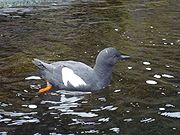Cepphus columba
From marinelife1011
The pigeon gullimot is a common auk of the pacific coast.
| Pigeon Gullimot | |
|---|---|
 |
|
| Scientific classification | |
| Kingdom: | Animalia |
| Phylum: | Chordata |
| Subphylum: | Vertebrata |
| Class: | Aves |
| Order: | Charadriiformes |
| Family: | Alcidae |
| Genus: | Cepphus |
| Species: | columba |
| Binomial name | |
| Cepphus columba Pallas, 1811 |
|
Contents |
Appearence
The pigeon gullimot is a medium sized auk (12 to 24 inches long) with a slender black bill. The bird has bright red feet and an equally red mouth lining. The breeding plumage is uniformly dark charcoal grey with large white patches on the upper-wing greater, median and,lesser coverts. A black wedge shaped mark extending part-way accross the white wing patches distinguishes this species from the cloesly related Black Gullimot. The underwing is charcoal grey but not as dark as the body. In winter the plumage is predominantly white with grey speckling on the crown, nape, mantle, scapulars and rump. The flight and tail feathers are always black.
Distribution
The pigeon guillimot is found near shore all along the entire west coast of North America; from northern Alaska to southern California.
Feeding behavior
This bird uses its short, narrow wings to "fly" underwater. It dives to the sea bottom to feed on small fish, mollusks, crustaceans and marine worms.
Nesting
The pigeon gullimot nests in caves, holes and crevasses in rocky cliffs next to the sea. In Puget Sound it has also been known to dig nesting burrows in clay banks. The birds nest in pairs or small colonies with each pair defending the immediate area around its nest hole from other birds. Two eggs are laid in each nest. The young emerge after an incubation period of 30-32 days. They take 29-39 days to fledge and take their first flight.
Sources
Terres, John K. The Audubon Society Encyclopedia of North American Birds, 1991, Wings Books, Random House, New Jersey.
Sibley, David Allen. The Sibley Guide to Birds, 2000, Chanticleer Press, Inc., New York
